Vetsuisse Report

2020 2022
Cover:
Demonstration auditorium from the audience perspective, Vetsuisse Faculty Zurich.
Back cover:
Demonstration auditorium from the lecturer’s perspective.
Inhalt The Vetsuisse Faculty Dean's Welcome 4 Facts & Figures 6 Appointments & Awards 8 Faculty Development Dean Roger Stephan on the strategic vision for Vetsuisse 12 Teaching Vice Dean Thomas Lutz on the new Vetsuisse curriculum 14 Teaching Awards 16 Graduation 17 Women in Science Third-party funded researchWomen in Science portrait series 19 Immunologist Salomé LeibundGutLandmann on fungal pathogens and why she always runs 21 Why researcher Hanna Marti is enthusiastic about Chlamydia 22 Physician Melanie Werner on diarrhea and solving a puzzle 25 Group leader Enni Markkanen on success and failure in research 26 Seeing patients with radiation oncologist Carla Rohrer Bley 29 How biochemist Raffaella Santoro makes complex matters easy to grasp 30 Oncology surgeon Mirja Nolff on what drives her research 32 One Health Institute The One Health Institute goes online this year 36 Science for the Public Science@vetsuisse to go 38 Research –Cultural Change Vice Dean Adrian Hehl’s commitment to more open science 40 Services Animal Hospital 44 Pathobiology and Veterinary Public Health 44 Investments Improvements to infrastructure 46 Image, Image concept 48
Prof. Dr. Dr. h.c. Roger Stephan
Dean & Head of the Institute for Food Safety and Hygiene
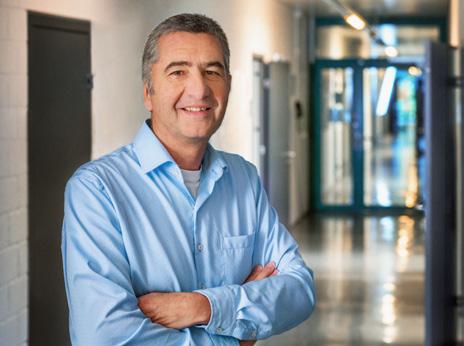
4 Vetsuisse Faculty UZH Annual Report 2022 Dean's Welcome
Greetings and credo from Zurich
I am delighted to introduce the second edition of our Vetsuisse Faculty Report covering the years 2021 and 2022.
Because around 90 percent of our students are women, a large portion of junior staff are also women. So, in this Report I would like to spotlight women in science, especially within our faculty. The Report will also highlight the breadth of research being done in veterinary science, ranging from basic to applied clinical research, and give an idea of how attractive research can be as a career path for young scientists.
And there are many more inspiring stories in this edition, for example, on the need for an open research culture or our efforts to introduce veterinary science research to a broad audience, as well as information about the main focus of the faculty development plan and insights into implementing the new curriculum.
The images throughout the Report reflect the importance of a networked approach, in particular an interdisciplinary approach to both research and clinical issues.
I wish you enjoyable reading.

Last but not least, I would like to extend my gratitude to the faculty, staff and students for all their efforts in the last two years!
Dean & Head of the Institute for Food Safety and Hygiene
5 Vetsuisse Faculty UZH Annual Report 2022 Dean's Welcome
Our Organisation
Department for Small Animals
• Clinic for Small Animal Internal Medicine
• Clinic for Small Animal Surgery
• Clinic for Zoo Animals, Exotic Pets and Wildlife
• Division of Radiation Therapy and Oncology
• Division of Emergency Medicine and Intensive Care
Department for Farm Animals
• Clinic for Farm Animals
• Clinic of Reproductive Medicine
• Division of Ambulatory Service and Herd Health
• Division of Pig Medicine
Equine Department
• Clinic for Equine Surgery
• Clinic for Equine Medicine
• Division of Opthalmology
• Division of Equine Performance
Department of Clinical Diagnostics & Services
• Pharmacy
• Laboratory Medicine
• Devision of Anaesthesiology
• Clinic for Diagnostic Imaging
• Intitute for Food Safety and Hygiene
• Section of Poultry and Rabbit Diseases
• Section of Veterinary Bacteriology
• Institute of Parasitology
• Institute of Veterinary Pathology
• Institute of Virology
• Institute of Animal Nutrition and Dietetics
• Section of Veterinary Epidemiology
• Intitute of Veterinary Anatomy
• Department of Molecular Mechanisms of Disease
• Muscular Skeletal Research Unit
• Center for Applied Biotechnology and Molecular Medicine
• Institute of Veterinary Physiology
• Institute of Veterinary Pharmacology and Toxicology
• Institute of Laboratory Animal Science
6 Vetsuisse Faculty UZH Annual Report 2022
Facts & Figures
Employees per 31.12.2022
Students per 31.12.2022
7 Vetsuisse Faculty UZH Annual Report 2022
Facts & Figures Total 770 Total 842 Bachelor 40% Doctoral candidates 35% Master 25% Number of students according to gender 84.3% 83% 17% 82% 18% Women Men Bachelor Bachelor Doctoral candidates Doctoral candidates Master Master 641 129 15.7% Administrative and technical staff Technical Operations 36 2 279 Non-professorial academic staff Professors Adjunct professors Administrative and technical staff Medical Lab 315 210
Appointed Professors 2021/2022
Claude Favrot
Associate professor ad personam for Veterinary Dermatology and Clinical Allergology as of April 1, 2021
Claudia Bachofen
Assistant professor for Virome Research as of August 1, 2021
Sophia Johler
Assistant professor for Food Microbiology as of August 1, 2021
International Awards for Faculty
Prof. Dr. Hans Lutz, professor emeritus for Clinical Laboratory Diagnostics, was admitted to the Academia Europaea in 2022.
Prof. Dr. Max Gassmann, Director of the Institute of Veterinary Physiology, was appointed by the Slovak Minister of Health as a Member of the Scientific Board of the Ministry of Health of the Slovak Republic.
PD Dr. Dennis C. Turner received the International Association of HumanAnimal Interaction Organizations’ (IAHAIO) inaugural Lifetime Distinguished Fellow Award in recognition of his outstanding achievements in the field of human-animal interaction.
Stefan Unterer
Associate professor for Small Animal Internal Medicine as of February 1, 2022
Matthias Marti
Full professor for Parasitology as of February 1, 2022
Enni Markkanen
Assistant professor for Pharmacotherapy and Toxicology as of April 1, 2022
Prof. Dr. Thomas Lutz, professor at the Institute of Veterinary Physiology, received the 2021 Hoebel Prize for Creativity from the Society for the Study of Ingestive Behavior (SSIB).
Prof. Dr. Claudia Reusch, professor emeritus for Small Animal Medicine, received the 2021 WSAVA Scientific Achievement Award in recognition of her outstanding contribution to endocrinology in small animal medicine.
Vetsuisse Faculty UZH Annual Report 2022 8 Appointments & Awards
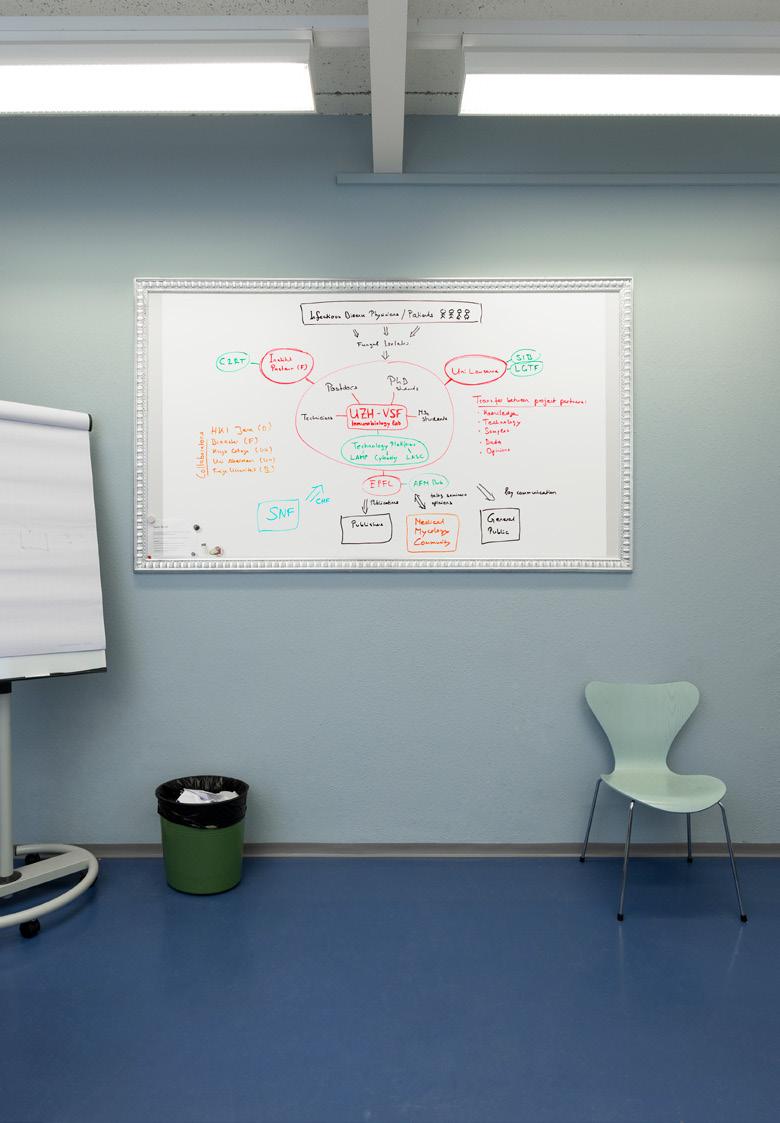
“Multidisciplinary approaches to identify genetic determinants of Candida albicans pathogenicity” by Salomé LeibundGutLandmann; Seminar room
 "FEATHER Trial" by Carla Rohrer Bley; Workroom, Small Animal Clinic
"FEATHER Trial" by Carla Rohrer Bley; Workroom, Small Animal Clinic
A framework for the future
Vetsuisse is moving forward with a faculty development plan that will promote interdisciplinary collaboration and efficient use of resources. A key aspect of thi s is the One Health Institute –a holistic approach to animal, human and environmental health. Text by Sameh Fahmy
The Vetsuisse Faculty at the University of Zurich is widely regarded as one of the world’s top institutions for veterinary medicine, and its leadership team has adopted a fouryear priority program to position the faculty for continued excellence.
Developed by Dean Roger Stephan and the faculty’s three vice deans, the Faculty Leadership Priority Program will guide strategic investments through 2026.
“For me it’s very important to give our faculty members something so that they see our strategy and how we want to bring the Vetsuisse Faculty a step forward,” Stephan says. “Our goal was to create a framework for the future development mainly of research and teaching.”
Building upon the Vetsuisse Faculty’s existing strengths, the framework promotes interdisciplinary collaboration and the efficient use of data, facilities and human resources.
Establishing the One Health Institute
A key element of the Faculty Leadership Priority Program is the establishment of the One Health Institute to be housed in the Vetsuisse Faculty but include University of Zurich faculty members, in a first step, from fields such as human medicine and environmental science.
One Health is a holistic approach that examines the connections between animal, human and environmental health. This approach informs the work of Vetsuisse faculty members who conduct research that addresses zoonotic diseases—which are transmitted between animals and humans—antimicrobial resistance, the prevention and treatment of cancer, and other areas where a narrow disciplinary approach would not succeed.
The establishment of the One Health Institute will build on this record of success and elevate the international prominence of the Vetsuisse Faculty and, by extension, the University of Zurich as a whole. Stephan adds that in addition to promoting collaboration among University of Zurich researchers, the One Health Institute will help connect university researchers with collaborators at institutions such as ETH Zurich and the Swiss Tropical and Public Health Institute.
“We are in a very competitive environment, and to be recognized as one of the best faculties we need lighthouses,”
Stephan says. “And we think one of our lighthouses at the faculty is the One Health approach.”
Fostering interdisciplinary collaborations
The establishment of the One Health Institute is just one way that the Faculty Leadership Priority Program is fostering interdisciplinary collaborations. Over the next three years, Stephan and his leadership team will launch a seed grant funding program to incentivize collaboration on translational research that requires expertise from basic researchers as well as clinicians.
In the area of cancer research, for example, findings from basic research on genetics may inform clinical treatment options. In another example, basic researchers from the Vetsuisse Faculty are collaborating with surgeons to manage inflammation. Bacteriologists are working with the hygiene team of the University Animal Hospital to better understand and minimize antimicrobial resistance. Each of these fields of study—cancer research, inflammation and antimicrobial resistance—have implications for human health, which demonstrates the importance of the One Health approach that Stephan and his colleagues advocate.
Stephan notes that seed grant funding will enable researchers to collect data that makes their proposals for external grants more competitive. “We’re going to make our seed grant programs stronger,” Stephan says. “We’ve seen that they can be really successful, but it’s only possible if you have the proper incentives.”
Strengthening partnerships
Another way the Faculty Leadership Priority Program is promoting interdisciplinary collaborations is through a new physician scientist track with the Faculty of Medicine that Stephan anticipates will begin in 2023.
The expanded collaborations Stephan envisions also extend beyond the University of Zurich. The AgroVet-Strickhof cooperation has been operational since 2017 with the aim of facilitating research and educational partnerships involving Strickhof—an education and research center of the canton of Zurich—ETH Zurich, and the University of Zurich.
Faculty Development Vetsuisse Faculty UZH Annual Report 2022 12
The collaboration has given Vetsuisse students hands-on learning opportunities that include working with AgroVet-Strickhof’s large herd of cattle, but Stephan says the collaboration also provides opportunities for translating basic research findings to the promotion of sustainability and animal welfare. “We also want to encourage translational research focused on farm animals,” Stephan says. “This is one of our plans for the next four to six years, so not only for the duration of our time in office but maybe also for the future.”
Increasing efficiency
Another major theme of the Faculty Leadership Priority Program is the efficient use of resources, from data to space to human resources.
To help effectively utilize the vast amount of data generated through clinical care as well as research in genomics, metagenomics, metabolomics and related fields, the Vetsuisse Faculty will invest in faculty members with expertise in data management and analysis.
The efficient allocation of physical space for housing animals is another focus of the priority program, as are efforts
to give faculty members protected time during which they can focus on research. At the University Animal Hospital, for example, the hiring of floor managers to coordinate patient care is helping anesthesiologists, surgeons and other members of the clinical team use their time more efficiently.
Mentoring and networking events are helping advance the careers of young scientists, and regular retreats allow faculty members to connect their areas of expertise with the broader priorities of the Vetsuisse Faculty.
When Stephan was first elected by his colleagues to lead the Vetsuisse Faculty in 2018, the four-year Faculty Leadership Priority Program that he and his vice deans developed was a first for the faculty. The new four-year plan builds on the successes of the initial plan and retains its spirit of transparency.
“Based on this strategy, all faculty members can really see in which direction we as a faculty board want to go over the next four years,” Stephan says.

13 Vetsuisse Faculty UZH Annual Report 2022
Sameh Fahmy, MS, is an award-winning freelance medical and technology journalist with a master’s degree in Science and Technology Journalism. He currently lives in Athens, Georgia, USA.
Faculty development plan under construction: The Faculty Leadership Program will establish new landmarks in veterinary medicine with data analysis, increased interdisciplinary collaborations and the One Health Institute.
"We are adopting a system that is also used in human medicine in Switzerland"
As Vice Dean of Studies at the Vetsuisse Faculty, University of Zurich, Thomas Lutz is overseeing the implementation of a new curriculum. In an interview, he speaks about the reform's most important features: performance assessment in clinical education and the implementation of the new state exam. Interview by Justus Krueger
Professor Lutz, the Vetsuisse Faculty has been introducing a new curriculum since the fall semester of 2021. What motivated the reform?
The introduction started in the fall of '21, in such a way that all students who started the bachelor's program or the first year of the master's program at that time studied according to the new curriculum. Other students have since followed suit, so the new curriculum is gaining ground year by year and we don't have overlaps between the old and the new system.
As to the motives: After about 15 years of the old curriculum, it was time to rethink our approach. Our curriculum has always been good, but we felt that the practical part of the program should be expanded. That is why the most obvious part of the reform is that the course has been extended by one semester.
This brings us to the second motive for reforming the curriculum. That is that the master's thesis has been compulsory for a good ten years, although for most students, no time was specifically reserved for it in the course, so providing more time makes sense.
The third motive was that certain minor subjects, such as poultry, wildlife, fish and bees, or herd problems, had not gotten enough attention in the past. We also used the reform to eliminate overlaps that had occurred over time.
The biggest changes are to the master's part of the program, and to the state exam that follows the completion of the master’s program.
Could you briefly outline the changes pertaining to the final exams?
This is perhaps best understood from the contrast with the time before the reform. At that time, the state exam existed in an older format, although it was known that it could not really be made objective. This was tolerated, within limits, because it was simply the standard for final examinations throughout Europe.
Another difference between the old and the new state examination is that the final exams used to take about four months. Instead of such a lengthy process, we will now have about two days for the written exams and then about two, three weeks later there will also be a one-day OSCE (objective structured clinical exam). That means all students are through with the entire state exam within three weeks. Reforming the curriculum while also reforming the final exams –
Over time, however, we have come to believe that we should change our approach so as to make exams and results more comparable. Based on experience from the last 15 years, we concluded that we should adopt the same system as human medicine in Switzerland for many years. Our new state examination will now be formally very similar to the state examination in human medicine.
that sounds like a difficult task. How did you go about it?
A central element is that we have a joint teaching commission with Bern, which planned the curriculum, because legally we are one faculty as far as education is concerned. So the curriculum in Bern and Zurich is identical in terms of the basic structure. This applies above all to the state examination, which is identical.
To ensure this, there is very close cooperation. A review process for the examination questions is currently underway, where Bern and Zurich agree on certain questions. For the final exam, Bern students should be able to answer questions that come from a Zurich lecturer and vice versa. We are well on track with this. At the same
Vetsuisse Faculty UZH Annual Report 2022 14
“Our new state examination will now be formally very similar to the state examination in human medicine.”
Prof. Dr. Thomas Alexander Lutz
“Bern students should be able to answer a question that comes from a Zurich lecturer and vice versa.”
Teaching
Prof. Dr. Thomas Alexander Lutz
time, it is obvious that there is still a lot of work to be done.
Did you encounter any particular challenges in implementing the new curriculum?
At the beginning of the reform, it became apparent that all of this initially meant more work for the students. The teachers sometimes overshot the mark with good ideas. But our students don't hesitate to give feedback, so we can react quickly and calibrate. Another point: As I said, the comparability of results and fair evaluation of students’ performance is crucial to the reform. This applies not only to final exams, but, for instance, to clinical rotations. In the past, at the end of each week of a rotation, each student would have a discussion with a supervisor, and there was more of a ge -
neral feedback - yes, you did that well, or no, you didn’t do that so well. With the reform, we are instead intro -
ducing a system in which students take small, relatively short partial exams, about once or twice a week. There is an electronic portfolio and the exams are graded in a more objective, comparable way. The introduction of this system has proven to be quite challenging. This is an iterative process, but the idea is good, and we are on track there to implement necessary adjustments.
Justus Krueger, based in Hong Kong, is an independent and frequent contributor to Stern, Berliner Zeitung, Spiegel, NZZ, and many other publications. His experience as writer extends to business, health and technology.

15 Vetsuisse Faculty UZH Annual Report 2022
“The comparability of results is crucial to the reform.”
Prof. Dr. Thomas Alexander Lutz
Prof. Dr. Thomas Alexander Lutz, professor for Veterinary Physiology at the Vetsuisse Faculty, University of Zurich, studied in Berlin and Zurich before obtaining his PhD at the University of Brisbane in 1995. He was appointed professor at the Institute of Veterinary Physiology, Zurich University in 2004. Professor Lutz is currently the Deputy Director of the Institute.
Virbac Best Coach Awards
Each year, the Vetsuisse graduates elect their “best coaches”, meaning those individuals that stood out for their teaching commitment during the students’ clinical rotational year. Veterinarians and animal caretakers from all clinics and the Institute of Veterinary Pathology are eligible. The award is sponsored by the company Virbac.
Virbac Best Coach Awards 2021 (for the clinical rotational year 2020)
Small Animals: Claudia Kümmerle, veterinarian
Simone Jäger, animal caretaker
Horses: Felix Theiss, veterinarian
Peter Schmid, animal caretaker
Farm Animals: Carina Oschlies, veterinarian
Canan Acar, animal caretaker
Pathobiology: Frauke Seehusen, veterinarian
Cédric Häuptli, animal caretaker
Virbac Best Coach Awards 2022 (for the clinical rotational year 2021)
Small Animals: Claudia Kümmerle, veterinarian
Tanja Tschigg, animal caretaker
Horses: Isabelle Piotrowski, veterinarian
Peter Schmid, animal caretaker
Farm Animals: Thibaud Kuca, veterinarian
Sascha Mark, animal caretaker
Pathobiology: Frauke Seehusen, veterinarian
Cédric Häuptli, animal caretaker
Teacher of the Year Vetsuisse Highlights
The teacher of the year is designated by the Vetsuisse students from the first to the fourth year. We congratulate:
2021: Prof. Dr. Peter Deplazes, professor for Parasitology
2022: Prof. Dr. Christian Gerspach, professor for Internal Medicine Ruminant
Honorary Doctorate 2021 Honorary Doctorate 2022
Awards from the University of Zurich (UZH)
Annual Prize UZH
Dr. med. vet. Bernd Coester received the University of Zurich’s 2021 Annual Prize.
Dr. sc. nat. Hanna Marti received the University of Zurich’s 2022 Annual Prize.
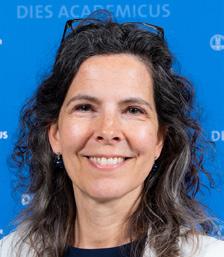
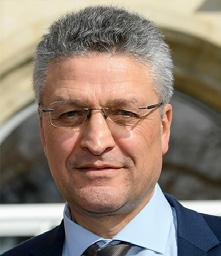
Semester Prizes UZH
Vanessa Heitzmann and Lucien Kelbert received UZH Semester Awards, Heitzmann for her master thesis "Validation of the Multidimensional Feline Pain Scale for Non-domesticated Cats in Rural Romanian Street Cats" and Kelbert for his master thesis "Seroprevalence of Toxoplasma gondii, Hepatitis E Virus and Salmonella Antibodies - a Data Collection in Swiss Fattening Pigs".
Prof. Dr. Lothar H. Wieler
The Vetsuisse Faculty of the University of Zurich has awarded an honorary doctor to Prof. Dr. Lothar H. Wieler for his great commitment to the promotion of human and animal health in line with the One Health concept with special focus on his role in the fight against the SARS-CoV-2 pandemic.
Prof. Dr. Debbie Jaarsma
The Vetsuisse Faculty of the University of Zurich has awarded an honorary doctor to Frau Prof. Dr. Debbie Jaarsma for her commitment to the scientifically based advancement of teaching and her inspiring ideas in creating an optimal learning and working environment for students and faculty.
Isabelle Wethli received a UZH Semester Prize for her master thesis "Examination of Indian Rhinoceros (Rhinoceros unicornis) and Wild Equids for Equid Herpesviruses".
Vetsuisse Faculty Awards
Dr. Nora Schreiber and Dr. Julia Maria Bruggisser received the 2021 Young Scientist Paper Award.
Dr. Cristiana Bersaglieri, Dr. Bastien Planchamp and Dr. Henning Richter received the 2022 Young Scientist Paper Award.
16
Teaching Awards Vetsuisse Faculty UZH Annual Report 2022
Graduation Ceremony 2021

Graduation Ceremony 2022
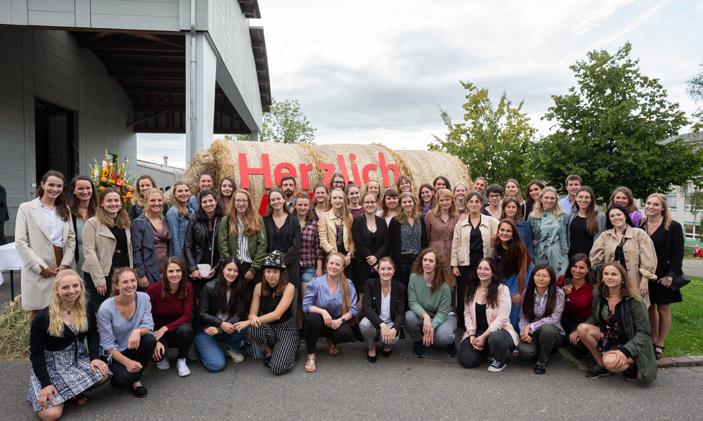
17 Vetsuisse Faculty UZH Annual Report 2022 Graduation
The Vetsuisse Faculty UZH bid farewell to its 65 newly graduated veterinarians with a festive event
The Vetsuisse Faculty UZH bid farewell to its 57 newly graduated veterinarians with a festive event
by Mirja Nolff; Operating theater B, Small Animal Clinic

"Near Infrared Imaging Surgical Oncology"
Seven women with different personalities and motivations – but one goal
. Who are some of the women in science at the Vetsuisse Faculty? What drives them, what gives them joy, what concerns them? And who are they outside of work? Our conversations with them have shown how very different they are. But also, that they shar e the same overarching goal: to expand the limits of current knowledge and medical treatment . Text (p. 20 – 31) by Santina Russo
Associate professor for immunology

Focus: fungal infections in animals and humans
S. 21
Focus: antibiotic resistance in Chlamydia
S. 22
Focus: gastroenterology, especially diarrhea

S. 25
Focus: cancer research and comparative oncology
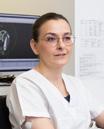




S. 26
Focus: radiation therapy of cancer in companion animals
S. 28
Focus: organization and regulation of gene expression
S. 30
Focus: sarcoma and comparative oncology
S. 32

Women in Science
Prof. Dr. Enni Markkanen Assistant professor for Pharmacology and Toxicology
Prof. Dr. Salomé LeibundGut-Landmann
Dr. med. vet. Melanie Werner
Attending physician
PD Dr. med. vet. Mirja Nolff Senior surgeon in Soft Tissue and Oncology
Dr. sc. nat. Hanna Marti
Postdoctoral researcher
Prof. Dr. Raffaella Santoro Associate professor for Stem Cell and Chromatin Biology
Prof. Dr. Carla Rohrer Bley Associate professor for Radiation Oncology and Head of the Department for Small Animals
19 Vetsuisse Faculty UZH Annual Report 2022
Santina Russo, PhD, is a freelance health and science writer based in Zurich, Switzerland.

Salomé LeibundGut-Landmann
very
speaking about the underrated relevance of fungal infections. Contrary to common knowledge they can get
serious, in animals and humans.
Group leader Salomé LeibundGut-Landmann is the only immunologis t in Switzerland whose research is fully dedicated to fungal diseases in humans a nd animals. Amongst other things, she investigates resistances against antifungal agents — a serious and largely unrecognized problem.
“Fungal diseases are chronically understudied and underrated,” says Salomé LeibundGut-Landmann, an associate professor at the Vetsuisse Faculty, at the start of our chat. In fact, she is the only immunologist in Switzerland with a research program fully dedicated to fungi causing diseases in humans and animals. Contrary to common knowledge, fungal infections can become very serious, especially in immunocompromised patients: “They can cause sepsis or lung infections that are difficult to distinguish from those induced by bacteria,“ says LeibundGut. “Even many physicians underestimate the occurrence and severity of fungal infections.”
We are sitting in her group’s seminar room when a student pops in with a question. “I’ll be right back,” says LeibundGut. She leaps up from her seat and jogs out of the room — to shortly return, still in a jog. Is she running so as not to keep us waiting or out of habit? “Oh, I always run,” she states matter-of-factly. “Moving slowly just seems a waste of time.” Indeed, the researcher has much to do, for many questions about the pathogenesis of fungal infections remain unanswered. In fact, most fungal pathogens are constantly present in our bodies, in mucosal tissues and skin, living in equilibrium with the host. “Only when the interplay between fungus and host is out of balance does an infection occur,” she explains. But how the healthy equilibrium is maintained during steady-state is still unknown — and the focus of LeibundGut’s work.
and non-allergic skin using cell cultures and mouse models. “The working hypothesis was that fungal overgrowth in allergic skin is connected to changes in the immune system,” she recounts. However, as her team recently discovered, not the immune system, but the composition of the skin cells and their secreted products are responsible, which provide the fungus with slightly different nutrients — and thus favor fungal growth.
Resistant fungi: an unrecognized problem
Recently, LeibundGut has also launched a project to investigate resistances against antifungal agents — which are as big a problem as resistances against antibiotics, she says. “This is fueled by pesticides used in agriculture.” To fight plant pathogens, antifungal agents are generously sprayed over fields, and resistances that develop due to the imposed selection pressure can spread widely via fungal spores — and enter humans and animals with the air they breathe.
To learn more, LeibundGut’s team started to analyze fungal isolates from the zoo, especially from aviaries of exotic birds and penguins. Birds can get fatally ill from a fungus named Aspergillus that is known to develop antimycotic resistance. “We aim to establish which resistances are already in circulation, and how frequently they occur, to get an indication on how to address them.”
Does the professor ever get times of leisure? Yes, with her family, a husband and two kids, and on vacations. “But sometimes my family has to remind me to take breaks,” LeibundGut admits. “As a researcher and group leader, you need dedication, creativity and perseverance, since ideas and goals, also obtaining the financial means for conducting the projects, all depend on your commitment,“ she continues. “At the same time, this provides for flexibility and creative freedom that is incredibly fulfilling.”
Not the immune system for once
One of her research subjects is Malassezia, a fungus that colonizes the skin. If Malassezia colonization is dysregulated, it can cause eczema — in humans but also in pets, especially dogs. The itching from the inflammation can get so severe that dogs scratch away their fur, inflicting bloody wounds. In humans, eczema flares can be triggered by different allergens such as wool or house dust mites. Therefore, LeibundGut’s team compared the cellular and molecular interplay between Malassezia and the host in allergic
Salomé LeibundGut-Landmann
is an associate professor for Immunology and the Head of Immunology at the Vetsuisse Faculty, University of Zurich. She obtained her PhD at the University of Geneva and worked as a postdoc at Cancer UK in London and the ETH Zurich. In 2010, she was awarded an SNSF professorship and started her own research group before moving to the Vetsuisse Faculty UZH in 2015.
“Moving slowly just seems a waste of time”
“As a researcher, you need dedication, creativity and perseverance. At the same time, the flexibility and creative freedom involved is incredibly fulfilling.”
21 Vetsuisse Faculty UZH Annual Report 2022 Women in Science
Salomé LeibundGut-Landmann
Hanna Marti is a playful enthusiast, in her research as in every thing else she does. She is currently puzzling out how an antibiotic resistance coul d have ended up in a bacterium that is particularly isolated from its environment — and in the process, is pushing the boundaries of what is known.
Once Hanna Marti, a postdoctoral researcher at the Institute of Veterinary Pathology, University of Zurich, starts talking about her research, she can hardly be stopped. Yet the organisms she is so enthusiastic about are generally rather unloved: Chlamydia, which most people associate with genital infections. “Chlamydia are an interesting bacterial group and relevant in a broader spectrum than many people realize,” says Marti, sitting in front of a workbench in her lab, clearly feeling at home.
Firstly, apart from humans, many different animals can get infected with Chlamydia — some species infect pigs, some birds, and some even fish. In sheep, an infection with Chlamydia abortus can result in aborted pregnancies in an epidemic scale: Up to half of a herd’s foetuses can be lost. Pregnant women who come into contact with sick animals can get infected too, and, in extreme cases, also suffer miscarriages. Secondly, these bacteria have some unusual traits. They can only grow inside of body cells. “As a consequence, they have delegated many of their bacterial functions to their host cells,” Marti points out. Amongst other things, they do not have the ability for conjugation, which is the process of exchanging sections of DNA that other bacteria commonly use to incorporate antimicrobial resistances. “All the more puzzling is the fact that a Chlamydia species, Chlamydia suis, which mostly infects pigs, acquired an antibiotic resistance gene.”
Solving a riddle
“Discovering how this resistance could have been transferred is key to establishing if this could happen in other Chlamydia species as well, and how to prevent it,” explains Marti. Indeed, she has a lead: a recently identified resistance in another bacterium, an Aeromonas species occurring in fish, possessing the exact same genetic sequence as the one in Chlamydia suis. “We assume that the resistance came from this Aeromonas species,” says Marti. This connection is not as far-fetched as it might appear: Many pigs in stock farming were and are still fed fish meal — this way, the resistance from Aeromonas might have ended up in a pig's intestinal tract and transferred to Chlamydia suis.
But is such a transfer possible? “Although we managed to find a condition in the lab in which Aeromonas could co -
exist in one cell with Chlamydia, we had to conclude that a transfer by such a co-infection is unlikely,” says the researcher. This was confirmed when she discovered that the plasmid carrying the resistance, a circular piece of DNA that can easily migrate between different bacteria, is not readily taken up by Chlamydia — this requires certain Chlamydia-specific DNA sequences. “Still, there are other possibilities for a transfer that we have not tested yet,” Marti says in her energetic way. Her next step in solving the puzzle is to test transferring the plasmid in vesicles, meaning droplets that enclose the DNA in a membrane.
Could she work on something other than Chlamydia with the same enthusiasm? “Absolutely! Immersing myself in a subject and making progress, that’s what makes me happy.” She would recommend all young researchers to go abroad for a while, like she did as a visiting scholar in Oakland, California. “Getting to know new lab cultures forces you to question yourself, and you get new inputs — things you might never have thought of otherwise.”
Her life is not all work though. Her Saturdays are devoted to her nieces and nephews, playing games like Monopoly, or just chatting away. Moreover, in her free time Marti is a writer of fan fiction based on various TV shows as well as the J.R.R. Tolkien universe, and of original fantasy stories. She has already published a total of 800,000 words. By way of comparison: This text about her is a mere 614 words long.
Hanna Marti studied veterinary medicine at the Vetsuisse Faculty, University of Zurich. She was a visiting research fellow at the UCSF Benioff Children’s Hospital in Oakland, USA, before returning to the University of Zurich for her PhD in the Microbiology and Immunology graduate school. Since 2020, she is a postdoctoral fellow at the Vetsuisse Faculty.
“Immersing myself in a subject and making progress makes me happy”
“Working abroad for a time forces you to question yourself, and you get new inputs — things you might never have thought of otherwise.”
Vetsuisse Faculty UZH Annual Report 2022 22 Women in Science
Hanna Marti
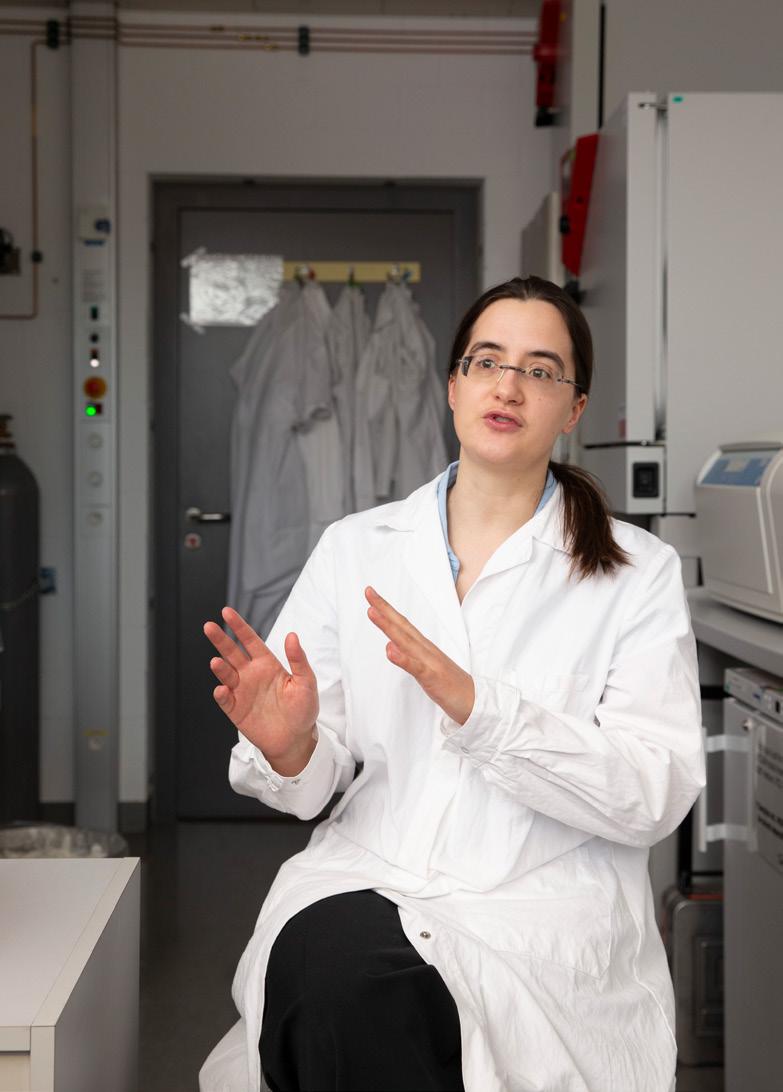
Enthusiast Hanna Marti feels at home in many subjects, from antibiotic resistance to writing fantasy stories, as she recounts in her lab.

Melanie Werner looking neat as a pin – unlike
research
her
subject: The physician works to improve therapy of diarrhea.
Melanie Werner is both, a physician and a researcher — an ideal combination, she says. Her main subject is, however, not exactly a savoury one: diarrhea. But more importantly: Her interest in this field of research almost all about feces was fuelled by a crucial mistreatment in veterinary medicine.
Melanie Werner deals with feces. A lot. In fact, her professional life is almost exclusively about feces and diarrhea. And replacing certain feces with other feces. But here’s the thing: Feces are an important indicator of health, linked to the well-being of the intestinal system, and can also serve as a promoter of intestinal health. As an attending physician at the University Animal Hospital with a specialization in gastroenterology, each day Melanie Werner spends in the clinic, she sees cats and dogs with acute and chronic diarrhea — a clinical sign that is treated with antibiotics in more than half the cases, as studies have shown. However, “diarrhea is not caused by a single bacterial pathogen in the vast majority of cases,” says Werner. “Which means that not only is the prescribed medication ineffective, but it also spurs the development of multi-resistant bacteria.”
is transferred rectally from a healthy donor to a sick recipient. For instance, for a Jack Russel Terrier of six kilos, a mere 30 millilitres of material are inserted with a syringe. “The procedure is gentle, a bit like taking the temperature,” says Werner.
A microbiome out of balance
The researcher, puzzled by the fact that antibiotics were applied so often without any foundation, decided to help change that. Among other things, she investigated the microbial background of chronic diarrhea by analysing dogs’ feces samples for many bacterial pathogens such as Salmonella and Campylobacter — and exonerated them as the origin of the clinical signs. Instead, Werner discovered that the entire intestinal microbiome is significantly changed in affected compared to heathy dogs. In particular, the bacterial composition consisting of many trillions of organisms is frequently altered, with certain subgroups increased in number, and others all but missing. “We are constantly learning more about which bacterial groups are relevant for intestinal health,” says Werner. For instance, some bacteria are required for crucial metabolic processes to run and can trigger inflammations when absent.
While such intestinal imbalances cannot be remedied by antibiotics, a procedure that was invented in China centuries ago and has recently returned to medicine, helps: a fecal transplant. The procedure is simple: A feces sample
Establishing a bank of feces
Shortly after the transplant, the recipient’s microbiome will align with the healthy one of the donor feces. However, the initial cause of the imbalance needs to be addressed as well. “Frequently, the source lies in the diet, which may contain a substance that the animal does not tolerate”, Werner explains. “Other patients turn out to have immunological problems that need to be treated with medications.” By now, her team performs fecal transplants around five times a week. “As one of our big projects we have also started to establish a feces bank with a collection of samples to use for our patients.” The feces are frozen at minus 80 degrees Celsius or lyophilized. In both cases, the bacterial population remains viable.
“The great thing about a university environment is that it offers the opportunity to combine being a veterinarian with doing research,” Werner points out. She just started supervising two doctoral students and plans to habilitate in the next few years. She recommends young researchers to soak up as much knowledge and experience as possible at the beginning of their careers, and to take on tasks when the opportunity arises. “Only by seeing a lot, you grow into a person able to advocate your own opinions.” Even when not working, Werner’s path is looking up: She goes hiking summer and winter and likes high-altitude tours. “Exercising in nature, that’s just a very rewarding feeling.”
Melanie Werner
is a senior clinician focused on small animal gastroenterology and the modulation of the gastrointestinal microbiome. She obtained her veterinary degree at the Ludwig-MaximiliansUniversity in Munich in 2016. After gaining her doctoral degree and completing her residency in internal medicine, she joined the Vetsuisse Faculty in 2022.
25 Vetsuisse Faculty UZH Annual Report 2022
“I was puzzled: Why are antibiotics applied without any foundation?”
“Here, the prescribed antibiotics are not only ineffective, but they also spur the development of multi-resistant bacteria.”
Melanie Werner
Women in Science
Enni Markkanen is a jack of all trades: She investigates differen t types of cancer to improve therapies for cats and dogs, but also for human patient s. In her private life, she is a wife and mother, and a one-woman rescue mission for animals in need.
Enni Markkanen does it all — this is the impression one inevitably gets when speaking to her. As an assistant professor for Pharmacology and Toxicology at the Vetsuisse Faculty, University of Zurich, she is a successful research group leader. She is also a wife, the mother of an eightyear-old son and the owner of several horses that she rides in competitions. She shares her home with three dogs and three geckos. “I’m no good at sitting around, and maybe also rather efficient at the things I do,” she comments, without really revealing her secret.
In her research, she investigates different types of cancer, including breast cancer, which is not only the most common of cancers in women, but also in female dogs. “In particular, we take a closer look at the tissue surrounding tumors, the stroma,” says Markkanen. “Though often overlooked, cancer-associated stroma has a strong influence on tumor growth.” With a method called laser capture microdissection, Markkanen’s team can resect very small areas from tumor sections or biopsies to study them. Using RNA sequencing and proteome analyses, the researchers compare the protein fingerprints of these samples with those of healthy tissue — in dogs, cats and humans. Markkanen’s team notably discovered that the stromal fingerprint is very different in benign breast cancers than in malignant, and that these differences in dogs are strikingly like those in humans. Thus, the researchers established a basis to pursue promising protein targets to develop possible new anti-cancer therapies for both canine and human patients.
Frequent in dogs, rare in humans
In another project, she collaborates with Mirja Nolff, a senior surgeon in Soft Tissue and Oncology, to find a way to better distinguish tumor and healthy tissue in soft tissue sarcoma (see p. 32). “These kinds of tumors are quite frequent in cats and dogs, but comparatively rare in humans,” says Markkanen. While this sounds like good news for humans at first, it also means that there is a lack of research on the subject in human medicine. “With such rare tumors it can be difficult to even gather enough patients for clinical trials,” Markkanen explains. “Nevertheless, there is a need to better understand and treat sarcoma.” These tumors originate from connective tissue cells, which have a longer life cycle and a different metabolism from the epithelial cells most other cancers develop from. “Conse -
quently, conventional anti-cancer drugs are often ineffective for sarcoma,” the researcher points out. Again, the research works towards both helping animal patients and finding indications on new therapies for human patients.
Don’t dwell on failures
“The great thing about science is that you can investigate questions that no one has asked before,” Markkanen says. “Plus, a career in research allows for an unusual amount of self-determination and flexibility.” Markkanen’s recommendation to young scientists: “Pursue what you enjoy. Don’t dwell on failures too much, they are just part of research, but try to learn from them for the future. The key is perseverance, continuing with a new angle, a new idea. This is where success comes from.”
Apart from working to improve cancer therapies, Markkanen is a guardian of animals in her private life — of hedgehogs in particular. In the last few years, she and her husband have nursed back to health around 200 hedgehogs that were sick or injured. Also, she hand-raised her cat Mr. Bond, who sadly passed away a few months ago, after finding him as an abandoned kitten a few days old during her holidays. The family’s three dogs are rescues as well, coming from animal shelters. Like Rocky, a Corgi-Jack Russell mix, who had lived in a shelter for four long years. Does she feel compelled to take in animals that have no other home? “Maybe a bit, but I have decided that three dogs are enough, at least for now.” There’s a lingering feeling though, that if she were to come across another animal in need, she would not hesitate to give it a home.
Enni Markkanen studied veterinary medicine and obtained her PhD in 2011 from the Faculty of Science, University of Zurich before spending some time as a postdoc in molecular cancer research at the University of Oxford. She returned to the Vetsuisse Faculty in 2015 and was appointed assistant professor for Pharmacology and Toxicology in 2022.
“Perseverance and a new angle on a problem — this is the key to success”
“A career in research allows for an unusual amount of self-determination and flexibility.”
Vetsuisse Faculty UZH Annual Report 2022 26 Women in Science
Enni Markkanen

Enni
Markkanen focused and talking fast while explaining her research. "I'm not good at sitting around," she says.
 Carla Rohrer Bley in the radiation therapy facility, where she treats cats and dogs with cancer. Her goal: to improve current treatments.
Carla Rohrer Bley in the radiation therapy facility, where she treats cats and dogs with cancer. Her goal: to improve current treatments.
Carla Rohrer Bley is rock solid and calm, and maybe she has to b e. For in addition to being the head of a team and a department, she is a teacher, a clinician and a researcher — that’s a lot to keep in balance. Above all though, her care is for her cat and dog patients and for improving the outcomes of their cancer therapies.
The first patient today was a beautiful rusted red male Irish Setter. The animal is still sleeping on a mat on the floor of the radiation therapy facility but will soon wake up from anesthesia. “He has a malignant tumor in his nasal cavity,” says Carla Rohrer Bley, Head of Radiation Oncology at the Vetsuisse Faculty, University of Zurich, “but we were already able to reduce it considerably.” Her team conducts around 1,800 radiation therapy sessions per year on cats and dogs with tumors in the mouth-nose area, the brain, the liver and other organs. The next patient is already being prepped, a male French Bulldog suffering from a tumorous growth in the oral-nasal cavity. He has been given an anesthetic, and is now being placed on a custom-made pillow, and equipped with a custom-made bite block, to optimally orient the tumor for the high-energy X-ray beam.
tients. It would be great if we could reach such an outcome for far more patients.”
In addition, the researcher has just started a clinical study for cats with oral cavity cancer that uses proton beams instead of high-energy X-rays as a therapy. “Here, we are testing a whole new method, a FLASH irradiation, where the tissue is exposed for mere milliseconds,” says Rohrer Bley. The aim is to reduce the side effects of the therapy. “With current methods, the radiation will often induce an inflammation and some pain in the cats’ mouth region for a couple weeks. We would like to abate this.”
Happy doctor, happy patient
Still, since the growth must be irradiated thoroughly, and the X-rays piercing it will re-emerge on the other side, there is no way around healthy tissue near the tumor being affected. “This is especially tricky with tumors in the facial area, since you want to impact the eyes and the brain as little as possible,” says Rohrer Bley. That’s why the specialists adjust the radiation field to the shape of the tumor the best they can. There is, however, one aspect not yet adapted to individual tumors: the radiation dose.
Heterogeneous dose to better treat patients
“While we irradiate regions near sensitive organs as little as possible, we could maybe do more to irradiate safe tumor regions with higher doses, and thereby improve the prognosis for the patients,” Rohrer Bley explains. She is currently carrying out a clinical study with dogs suffering from nasal and brain tumors to test the effect of therapy with such heterogeneous doses. “This should eliminate the tumor more efficiently, while also keeping the side effects in check,” says Rohrer Bley. “Until now, we could control brain tumors for two years in around half the pa-
As a person, Rohrer Bley has a steady quality about her that feels soothing. She is strong, like a rock. Is that because she must be calm for her animal patients that would pick up on any nervousness? “Maybe a bit, but mostly it’s just my personality, I think.” The trait is helping her balance her roles. For Rohrer Bley is not only a clinician, team leader and researcher, she is also the Head of the Department for Small Animals, and responsible for the radiation oncology training of students and personnel. “This makes for a challenging mix,” she admits. “Things are often stressful, but also never boring and spiced with rewarding moments.” She does have free time away from work though, which she likes to spend with her husband, her friends, by going on gravel bike rides, and tending to her garden. “Even if your work is important to you, it is equally important to take good care of yourself — even when you are a young researcher or clinician just at the start of your career.”
Meanwhile, her patient, the Irish Setter, has awakened in good spirits and is curiously taking in the goings-on around him. This was his second-to-last radiation session, says Rohrer Bley and smiles. “Things are looking very good for him.”
Carla Rohrer Bley
is the Head of Radiation Oncology and the Department for Small Animals at the Vetsuisse Faculty, University of Zurich. After her studies in veterinary medicine at the University of Bern, she obtained her diploma in veterinary radiation oncology in 2003 and was a lecturer in radiation oncology from 2006. After achieving her habilitation in 2012, she was appointed professor for Oncology in 2015.
“It would be great to reach such a good outcome for more patients”
“Being a clinician, researcher and teacher makes for a combination that is often stressful, but never boring and spiced with rewarding moments.”
29 Vetsuisse Faculty UZH Annual Report 2022 Women in Science
Carla Rohrer Bley
Raffaella Santoro is a loud and cheerful person, and an extremely successful scientist. Her advances in researching how genes are regulated are not limited to animals or humans, or a specific disease. They are at the core of what makes all cells work.
The first thing one notices in Raffaella Santoro's office is a child’s game on her visitor's table: “Who am I,” a game of little cards with drawings of faces on them used to learn basic adjectives. In Santoro’s edition, these are pasted over with photos of her 15 group members. “My Secret Santa Christmas gift,” says the professor for Stem Cell and Chromatin Biology, smiling. “Not that I will ever forget my team,” she comments, now with a cheerful laugh that reaches the far edges of her office. The room is as colorful as its owner, featuring a bright green sofa with flower patterned cushions, high gloss journal covers on the wall, and a bowl with balls of yellow, blue, and pink wool yarn on the shelf. As it turns out, the woolen balls have a purpose: They help the biochemist to explain her research.
“The bowl is the cell nucleus,” she says, “the woolen balls within are chromosomes, and the balloon in the middle is the nucleolus.” The nucleolus is where the ribosome is biosynthesized, the machinery that produces all cellular proteins. In addition, as Santoro discovered, the nucleolus has an important function in the regulation of gene expression, meaning, in the regulation of which genes are read out to produce the corresponding proteins. Proteins, in turn, are necessary to perform the cells’ tasks. Be it a brain, liver or blood cell, each cell needs different protein ensembles at certain times, and the foundation for these working ensembles is a regulated gene expression. How this happens, is the core question of Santoro’s research.
Key to being able to investigate this process at all, was a new method Santoro developed, which allowed her to label the genes touching the nucleolus: A bacterial enzyme is directed into the nucleolus, and then stamps every DNA section touching it with a chemical group that can be easily recognized in analysis. “It’s a molecular trick we can now use to study the role of the nucleolus in detail and address important questions to understand how genes are regulated,” explains Santoro.
The creativity of research
First, her team validated the method by pinpointing active and inactive genes in well-known mouse stem cells, thus mapping their dynamically changing chromosome structure. More recently, the team has started to apply the method to cancer cells as well as cells of people suffering from Progeria, a genetic disease that causes premature aging. “Our goal is to find out how healthy and disease cells differ in the organization and expression state of genes around the nucleolus, and identify potential targets for early diagnosis and treatment,” Santoro explains.
She believes creativity to be an essential factor in research. “As a researcher, you have to be something of an artist, to be able to think outside of the box.” As with her projects: At the outset the idea was to engineer a protein that could mark DNA at the nucleolus. Previously, there was simply no way to study the chromosomes’ organization at the nucleolus.
Why genes are activated — or not
“We knew the molecular players required for gene expression, and that active genes are often found around the middle of the nucleus, whereas inactive genes are frequently found at its rim, huddled against its membrane,” Santoro explains. Her research has now shown that the nucleolus has a similar role: DNA sections nestled up to it are inactive for expression. “In fact, the chromosome fibers are continuously changing their structure and the position of the genes, depending on which ones are to be activated or deactivated.”
In her leisure time, the native of Rome is an expert cook, inventive in recreating Italian recipes. However, the term “leisure time” is a relative one for Santoro. “Even when I am not in the office at weekends, my head is working, spinning around projects or ideas. For me, my research is as much a hobby as work.”
Raffaella Santoro
is a professor for Stem Cell and Chromatin Biology at the Department of Molecular Mechanisms of Disease at the Vetsuisse Faculty, University of Zurich. After her PhD in biochemistry at La Sapienza University in Rome, she was amongst other things a postdoc at the German Cancer Research Centre in Heidelberg. She joined the University of Zurich in 2009 and was appointed professor in 2019. For her research, Santoro was awarded a European ERC Advanced Grant.
“Creativity is an essential part of research”
“We use a molecular trick to study the role of the nucleolus, and to address questions on how genes are regulated.”
Vetsuisse Faculty UZH Annual Report 2022 30 Women in Science
Raffaella Santoro
 Raffaella Santoro has found a creative and playful way to explain her fundamental research: The bowl of woollen balls represents the cell nucleus with its chromosomes.
Raffaella Santoro has found a creative and playful way to explain her fundamental research: The bowl of woollen balls represents the cell nucleus with its chromosomes.
patient”
Mirja Nolff’s research is driven by the direct needs of her patients – cats and dogs suffering from cancer. However, her results might one day also benefit human patients, as she is working towards better connecting human and animal med icine.
“Keep your heels, your head, and your standards high,” reads the sign hanging on Mirja Nolff's bookcase. More often than heels, however, she wears comfy Crocs as many surgeons do when operating. But her standards are up there, and her head is often racing with new ideas. Mirja Nolff is a senior surgeon in Soft Tissue and Oncology at the Clinic for Small Animal Surgery and has specialized in the removal of sarcoma — malignant tumors growing in muscle or connective tissue. Such sarcomas occur in humans as well, but only rarely, and there is need for more research on the subject. “We believe that our projects might one day also benefit human patients along with our pet patients,” says Nolff.
In an ongoing clinical trial with dogs, Nolff established that the use of such dyes improves the surgical outcomes. “However, the agent we are currently using is not solely specific for tumors but can also label other tissue,” Nolff points out. Recently, her search for more specific targeting yielded an important result: A comparison of dog sarcoma protein fingerprints with cats with the same tumors pointed to interesting future protein targets — in both species. Now, Nolff and her colleague are extending their analyses to samples from humans obtained from their collaborators at Charité University Hospital Berlin.
“Teaming up is key”
“The biggest problem we have in the removal of sarcoma in cats and dogs is the difficulty to distinguish malignant from healthy tissue,” she explains. “The edges of a sarcoma are invasive and can have thin extensions that are neither visible in CT or MRI imaging, nor directly detectable by the surgeon.“ Therefore, an ample margin of tissue around the tumor must be removed to have a chance of getting all cancer cells. “This need to remove a large portion of healthy tissue is very unsatisfactory, especially as it is no guarantee of getting all the tumor cells out,” Nolff states. She is looking for methods to better identify tumor margins to then be able to perform the surgeries with higher precision.
Making tumors visible in surgery
From a drawer, Nolff pulls a box of samples: processed sarcoma sections from current dog patients. Together with researcher Enni Markkanen at the Vetsuisse Faculty (see p. 26), she has already analyzed the protein composition in other such samples from cats and dogs. “We know that tumor cells produce different proteins and protein quantities than other tissues,” she explains. “In mapping these specific protein fingerprints, we hope to find protein targets that allow us to specifically label tumor cells.” The goal is to make tumors clearly visible in surgery using specific fluorescent dyes.
“The possibility of such close collaborations, as with Markkanen, is one of the strengths of our faculty,” she believes. “Every partner has their unique strengths — without Enni we would lack the expertize for molecular sequencing, while on our side, we know the clinical needs. Teaming up is key.” Nolff also stresses that in the US, comparative medicine, meaning the connection between veterinary and human medicine, is much more advanced than in Europe, and that moving forward in this regard would be desirable — for sarcoma as well as other fields. She is herself actively promoting the concept of comparative oncology on social media.
For her, medical care is more than treating single patients. “Each of my patients is important to me. But being at the University also enables me to work to improve care for all future patients out there, and, in the best case, also future human patients.” The road is not always easy, says Nolff. “For each success you get many rejections, like for grant applications. But this is part of research.” And it’s worth it, she says: “I am convinced we can find a way to specifically label tumors — and we will be sure to celebrate the success.”
Mirja Nolff is an attending soft tissue and oncology surgeon. After studying at the University of Hannover and completing her specialization in small animal surgery in 2017, she worked at the Clinic for Small Animal Surgery at the Ludwig-Maximilians-University in Munich. In 2019, she obtained her habilitation and shortly after joined the Vetsuisse Faculty.
“Medical care is more than treating a single
“The projects we conduct in veterinary oncology might one day also benefit human patients.”
Vetsuisse Faculty UZH Annual Report 2022 32 Women in Science
Mirja Nolff

"It's
not always easy to get clinical research projects under way – but always worth it," says surgeon and researcher
Mirja Nolff.
Melanie Werner; Endoscopy room, Small Animal Clinic

"Relevance of Giardia in Infection in Dogs" by
 "Soft Tissue Sarcoma" by Enni Markkanen; Media room, Small Animal Clinic
"Soft Tissue Sarcoma" by Enni Markkanen; Media room, Small Animal Clinic
One Health
The last few years have provided ample evidence that the health of humans, animals and their environment is closely related – they constitute one health. This has long been a research focus and strategic aim at the University of Zur ich. Starting this year, however, this approach will have an institutional home at the University, the new One Health Institute. Text by Justus
Krueger
The new institute will focus on three areas: zoonotic diseases, drug resistance, and integrated approaches to metabolic disease or cancer research in humans and animals. In addition to these three focal points, the intersecting disciplines of epidemiology and evolutionary science also have a crucial role to play in the new institute.
The urgency of this type of research is obvious. COVID-19 is the most recent example of a zoonotic disease, but there have been many others, such as HIV, SARS in 2003 and MERS since 2012. Equally, drug resistances have a high degree of relevance in the context of One Health – as with zoonotic diseases, drug resistances can migrate from human to animal and vice versa.
The institute is still in the process of constituting itself. "This requires a lot more administrative steps," says Thomas Lutz, Deputy Director of the Institute of Veterinary Physiology at the University of Zurich. "But the key point is: We exist."
Part of the background of the new foundation is that in late 2021, the University of Zurich started a new funding instrument, called TRANSFORM, aimed at facilitating cross-disciplinary research of the type to be conducted by the new institute.
"We then took the initiative", says Lutz, "together with the Faculty of Medicine and the Faculty of Science of UZH, to submit an application for the establishment of the One Health Institute, as an institute that comprises three faculties."
Laying the groundwork
The funds were granted in April 2022, and since then the foundation phase has been underway. The goal is to fill two assistant professorships this year, 2023, one in veterinary medicine, one in human medicine.
"We are currently working to have all the legal requirements approved by the University management and the
Board of the University," says Lutz, who also heads the institute's steering committee. He and his colleagues are laying the groundwork so that within the next few months, a structural commission will be able to select the professorships that will fill the new institute with life.
The aim is to establish these two professorships with a clear research portfolio, so as to give them as much freedom as possible and to burden them as little as possible with other tasks.
Nevertheless, teaching is part of the new institute's mission. A further goal, therefore, is to build up teaching modules within the first three years that will also cover other aspects, such as the sustainability of food supply or the environmental impact of animal husbandry. "We made a point not to focus solely on zoonotic diseases," says Lutz. "There is a growing number of institutes and networks covering that", so having a wider perspective is important.
While the two assistant professorships are at present the core of the target agreement for the new institute, the plans for the future go further.
European cooperation
A first step is to enable the institute to grow into a sizable network, and one move in that direction is cooperation with other European universities. A case in point is Una Europa, a network of European research-intensive universities. Within that network, One Health is a topic of interest. This means that the University of Zurich via the One Health Institute now has a direct connection to Una and can contribute directly to the European network.
"I think this is much better for the visibility of our research," says Lutz. "If for instance the virological institute would state that they would like to participate in Una Europa One Health, that would probably not have the same weight as taking part with a dedicated One Health Institute. I think that puts us in a better position."
One Health Institute Vetsuisse Faculty UZH Annual Report 2022 36
To make this possible, all involved faculties have agreed to provide funds, resources and staff in addition to the core funding. Further, there is the possibility to work with the institute as an external partner, so the institute should be able to grow quickly and extend its reach through various levels of cooperation.
"Of course, on paper, everything always works perfectly," says Lutz, "but we are realistic enough to establish certain criteria to see if this will actually work in the manner that is intended."
Once the four years of initial research funding have expired, the expectation is that the new institute should have grown into a permanent institution that is able to support itself, attract third-party funding and become a significant node in the network of One Health research.
"Over the longer term, it would be nice if the institute would succeed in building sufficient expertise to develop into a competence center," says Lutz. "It could then serve as a reference point, in Switzerland and possibly abroad."
One World, One Health: Science needs to connect the health of humans, animals and environment
Veterinary medicine is a key player not only in the health of animals, but also in human health and the ‘One Health’ concept. “‘One Health’ denotes a holistic approach in which experts from different scientific sectors work together to address health issues that cannot be solved by each sector alone.
• A unified effort is needed Coordinated and harmonized scientific approaches, data collection and data sharing between clinicians and researchers across the human, animal and environmental domains are required. Only then can new trends, like new infection, be identified and chains of infections be followed and counteracted effectively.
• One Health Institute (OHI) This first interfaculty research institute dedicated to One Health is funded by the University of Zurich and allocated at the Vetsuisse Faculty.
• Two new professorships The goal is to fill two assistant professorships this year, one in veterinary medicine, one in human medicine, with a clear research portfolio.
• Closing knowledge gaps Scientists will combine their expert knowledge to work on cutting-edge transdisciplinary research questions in One Health. The initiative will also train a new generation of competent, interdisciplinary scientists.
• European network A first step is to enable the institute to grow into a sizable network through cooperation with other European universities. A case in point is Una Europa, a network of European research-intensive universities.
Justus Krueger, based in Hong Kong, is an independent and frequent contributor to Stern, Berliner Zeitung, Spiegel, NZZ, and many other publications. His experience as writer extends to business, health and technology.
37 Vetsuisse Faculty UZH Annual Report 2022
One Health Institute
Under the slogan "Research for animals and humans – 200 + 2 years of the Zurich Veterinary School", the Vetsuisse Faculty Zurich presented its work to the general public on June 29, 2022, in the main hall of the Zurich train station.
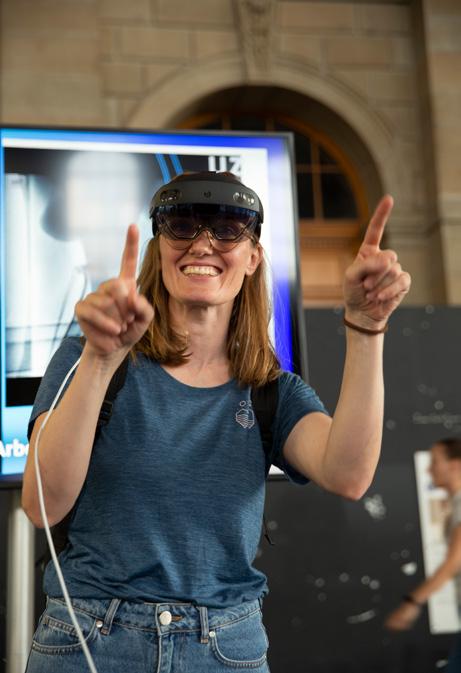
Founded in 1820, the Zurich Veterinary School had originally scheduled its anniversary in 2020. But like so much in the past two years, the celebration was postponed due to the pan-
demic. The Vetsuisse Faculty Zurich planned its event as an interactive tour showcasing the different research areas of veterinary medicine and how they serve both animals and humans.
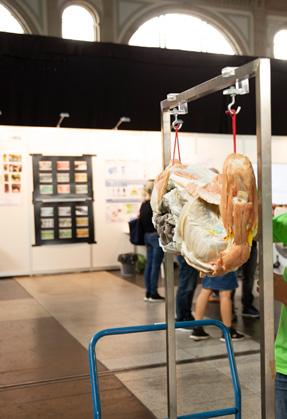
At a total of 21 booths visitors were invited to talk with scientists from the school’s institutes and clinics and enjoy an interactive experience of their research up-close. For instance, one could track down the secret life of
fungi and learn when and how the body defends itself against them, while tech enthusiasts could attend a knee arthroscopy. Another highlight was the diverse lectures that took place throughout the day in a custombuilt cube. The lectures were kept short in the spirit of Science-to-Go and invited train commuters to linger. Some stayed for one lecture, others spent half a day immersed in the world of veterinary science.
Thanks to the wide range of topics and the creative way researchers showcased their work, there was something to interest everyone. As a result, feedback on the event was positive and visitors were enthusiastic about the diversity of veterinary medicine.
Science@vetsuisse
to go
38 Vetsuisse Faculty UZH Annual Report 2022 Science for the Public
The bone was this big: HoloLenses at work
Examining a cow’s rumen

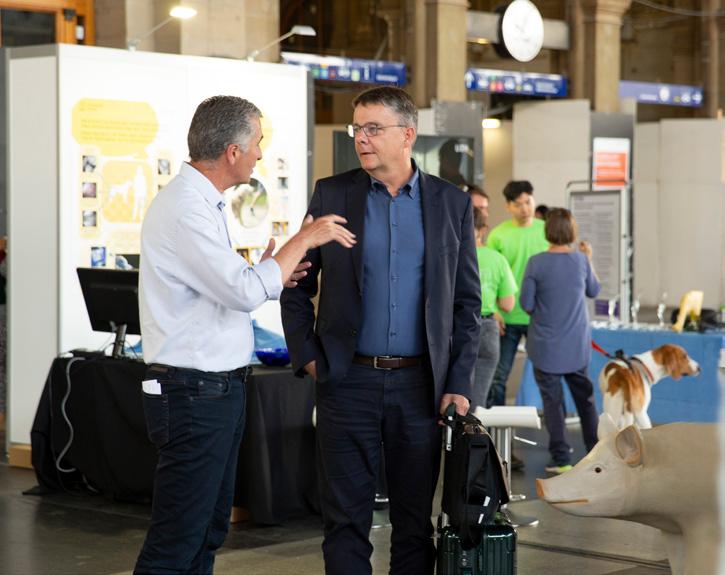
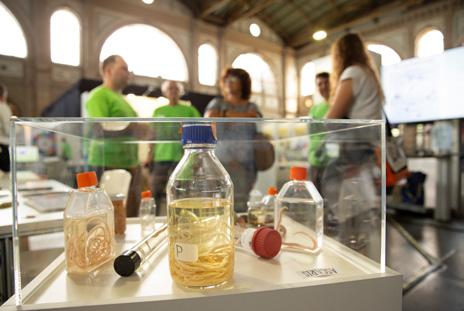
39 Vetsuisse Faculty UZH Annual Report 2022 Science for the Public
The exhibition stands offered much to see, touch, hear, test and debate
Rector of the University of Zurich Prof. Dr. Michael Schaepman speaks with Dean of the Vetsuisse Faculty, Prof. Dr. Roger Stephan during a visit
“We need an open research culture to be competitive”
When talking with Professor Adrian Hehl, Vice Dean of Research and Academic Career Development, about how to meet today’s research challenges the phrase “cultural change” keeps cropping up. A major shift in research culture is underway at the Vetsuisse Faculty, making it more open, interdisciplinary and innovative with a se ries of measures that include establishing the One Health Institute. Interview by Dr. Hildegard Kaulen
Professor Hehl, the Vetsuisse Faculty’s new One Health Institute is a momentous project supported by three UZH faculties. Can you tell us what it is?
Human, animal and environmental health are closely linked. So, the fundamental idea behind One Health is that veterinary medicine, human medicine and environmental sciences must work together across disciplines to stop the transmission of pathogens or curb antibiotic resistance, to name just two examples. No discipline has sovereignty over information. In fact, it’s often veterinary medicine that receives the first signals that a population is in danger. That's why physici-
which is why three UZH faculties participate in the institute: the Vetsuisse Faculty, the Faculty of Medicine and the Faculty of Mathematics and Life Sciences. The concept is an antithesis to the silo thinking you find at many universities. My vision is to develop a scientific environment that inspires, excites, and attracts excellent young scientists. We need an open research culture to be competitive.
How much international visibility do you expect from the One Health Institute?
currently discussing ideas like setting up a research hub, staffed with PhDs, in which young scientists with protected research time can rotate. At the moment, we’re exploring the feasibility and funding of such a hub. In our relatively small faculty building critical mass and dynamic research environments is particularly important.
ans and veterinary doctors should ideally sit in one room, because close communication and cooperation generate real added value. Right now, that's missing in many places. So, what we're dealing with at One Health isn’t a knowledge gap but a perception gap. We have to finally realize that we need this close and seamless collaboration to develop sustainable solutions for people, animals and the environment – and this means we need a change in culture.
How is One Health helping to bring about a cultural change?
One Health stands for an open and interdisciplinary research culture,
Of course, we want to position ourselves internationally, but first and foremost we have to decide on interesting and competitive projects. We’re still considering how broadly or specifically we’ll formulate the call for upcoming appointments. It’s important that the research topics are eligible for third-party funding and are genuine One Health topics that cover veterinary, human medical and, if possible, environmental aspects. We don’t want to have purely socio-political discussions. In the set-up phase, we’ll focus on three main areas: zoonoses, drug resistance and metabolism in the context of multi-organ crosstalk with epidemiology and evolution as cross-cutting subjects. Later, we’ll add more areas.
Will new training and career paths be needed for the cultural change?
It’s difficult to change the basic veterinary education because the curriculum would have to be changed too. But we are implementing protected research time at later career stages. For this, however, young scientists not only need leave and financing, but also a high-caliber research environment where they can get guidance and supervision. That’s why we’re
The Vetsuisse Faculty developed a roadmap for a Swiss Institute for Drug and Device Development (SI3D). What function should this institute have and what do you expect from it?
This project is about creating a national research infrastructure. The State Secretariat for Education, Research and Innovation along with swissuniversities called for roadmaps for research infrastructures of the future. We answered this call with a roadmap for SI3D and so far have passed all evaluations with top marks. The SI3D institute is to provide GxP services for all universities in Switzerland, securing scientific projects and innovations preclinically in such a way that industry can enter with justifiable risks for continuation. We’re now at stage 4, where the funding will be decided. Our roadmap calls for the pooling and further development of existing infrastructures as well as the development of new metastructures. At present, it’s difficult to translate findings from basic research into marketable products if the necessary standards such as GLP, GCP and GMP aren’t observed from the outset. This is exactly where SI3SD comes into play. We therefore expect the institute to provide a massive boost in translation of scientific research.
“Physicians and veterinary doctors should ideally sit in one room, because close communication and cooperation generate real added value.”
Research – Cultural Change Vetsuisse Faculty UZH Annual Report 2022 40
Professor Dr. Adrian Hehl
We’re also seeing more and more data being generated in science, making digitization and Big Data management major priorities. What plans and goals do you have to tackle this? Data is the new gold. So far, the Vetsuisse Faculty only uses data from the veterinary clinic, primarily for billing purposes. Time and again, we’re seeing that students don’t have statistically robust data for their master's theses because the data aren’t available, or the data quality is insufficient. So, we need better data management, better data quality and a resilient data architecture. We’re discussing open research data that everyone has access to and understands. But we’re going to have to put some effort into persuading people. Nobody wants to do more work. And we have to clarify issues around data protection, property rights and ethics, and set ourselves up technically so that our clinical information platform won’t collapse when a new interface is introduced.

Are there other areas that need more focus?
Yes, I’d like to say a few words about two ongoing pioneering projects that the faculty hopes will have a lasting impact on cultural development. One of these projects is called ORDVET. The aim here is to turn the existing biobanks into a central, cross-site biobank, link the samples with standardized metadata and ensure their interoperability and accessibility. With this project, we can also address weaknesses and a need for clarification in technical, legal and ethical issues or cultural questions. It’s about open science according to the FAIR principles. The second flagship project is called APES, which stands for Automated Patient Eligibility System. Originally, this was about prioritization
using an app, but it has developed far beyond that over the last year. If it’s determined that an animal being enrolled is a patient of interest for some reason, the app will put out an alert about the enrollment. This should make prospective studies much easier.
What is your personal vision for the Vetsuisse Faculty?
For me, it's about developing scientific environments attractive to all scientists. So, with every initiative I ask myself: Who is this going to benefit and what effect will it have on culture development in our faculty? In that regard, I’d also like to see the Veterinary Hospital and the veterinary science institutes grow even closer together and inspire each other. Which brings us right back to the ideas behind One Health.
41 Vetsuisse Faculty UZH Annual Report 2022
“It’s about open science according to the FAIR principles.”
Prof. Dr. Adrian Hehl
Dr. Hildegard Kaulen is a molecular biologist and writes as a science and medical journalist for numerous newspapers and science journals.
Professor Dr. Adrian B. Hehl studied biology at the University of Bern, spent four years as a postdoctoral fellow at Stanford University School of Medicine and has held various positions at UZH since 1998. In 2013, he was appointed professor for Molecular Parasitology. Since 2018, he has served as the Vice Dean of Research and Academic Career Development at the Vetsuisse Faculty.

"Nuclear Structure + Function in Development and Disease" by Raffaella Santoro; Seminar room, Irchel Campus
Resistance in
 “Tetracycline
Chlamydia suis" by Hanna Marti; Seminar room, Vetsuisse Faculty
“Tetracycline
Chlamydia suis" by Hanna Marti; Seminar room, Vetsuisse Faculty
Animal Hospital
The University Animal Hospital comprises all clinical facilities of the Vetsuisse Faculty. Number of animal patients in 2022:
Zoo Animals, Exotic Pets and Wildlife 5%
Cats 23%
51% Dogs
Pathobiology and Veterinary Public Health
In different institutes diagnostic services are provided in laboratories which are accredited according to ISO 17025. In addition, various national and international reference
Equine 14% Cattle 6%
Other Farm Animals 1%
29,084
Total Patients
laboratories (animal disease diagnostics, foodborne pathogens) are affiliated to these institutes.
Institute for Food Safety and Hygiene
Scope of diagnostic services: Microbiological testing of food samples for food companies.
Number of samples 2022: 23,000
National Reference Laboratory for Enteropathogenic Bacteria and Listeria (NENT)
Section of Poultry and Rabbit Disease
Scope of diagnostic services: Investigations for pathogens causing diesase in poultry, birds and rabbits.
Number of samples 2022: 27,000
National Reference Laboratory for: Avian Influenza, Avian Chlamydiosis, Infectious Laryngotracheitis, Myxomatosis, Newcastle Disease, Salmonella Infection of Poultry, Rabbit Viral Haemorrhagic Disease
44 Vetsuisse Faculty UZH Annual Report 2022
Services
Section of Veterinary Bacteriology
Scope of diagnostic services: Investigations for pathogens causing bacterial and fungal infectious diseases in animals.
Number of samples 2022: 7,922
National Reference Laboratory for: Bovine Tuberculosis, sheep and goat Pseudotuberculosis, Paratuberculosis
Institute of Parasitology
Scope of diagnostic services: Investigations for parasites causing infectious diseases in animals and humans.
Number of samples from animals 2022: 13,163
Number of samples from humans 2022: 7,473
National Reference Laboratory for: Echinococcosis, Cryptosporidiosis, and Hypodermosis
National Center for Vector Entomology
Institute of Veterinary Pathology
Scope of diagnostic services: Post mortem examinations of food and companion animals, exotics, zoo and wild animals, and laboratory rodents; histological and immunohistological examinations of tissue biopsies; examination of cytological specimens.
Post mortem examinations 2022: 1,700
Biopsy and cytology examinations 2022: 5,000
OIE Reference Laboratory for Ovine Chlamydiosis
National Reference Laboratory for Chlamydia abortion in sheep and goats
Institute of Virology
Scope of diagnostic services: Investigations for viruses relevant to veterinary medicine in pets, farm animals and zoo animals.
Number of samples 2022: 2,700
National Reference Laboratory for: Infectious bovine rhinotracheitis / infectious pustular vulvovaginitis in cattle (BoHV-1, IBR / IPV), Aujeszky's disease in pigs (SuHV-1, Aujeszky), transmissible gastroenteritis in pigs (TGEV)
45 Vetsuisse Faculty UZH Annual Report 2022 Services
How we improved our infrastructure in the last two years
Since the Vetsuisse teaching, research and clinical facilities are part of the larger Zurich University Irchel Campus, our construction projects are integrated into the university’s overall development strategy. According to this strategy, most of the Vetsuisse facilities are to be completely renewed within the next 30 to 35 years. Meanwhile, the short-term
development of our facilities will continue with refurbishments and strategic construction to advance our research efforts and improve the care of our animal patients. In the last two years, our construction developments were focused on two main aspects: modern diagnostic imaging for large and small animals, and a Skills Lab for teaching students.
Opening Ceremony for New Large Animal Imaging
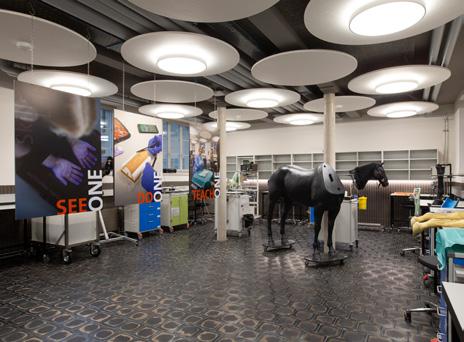
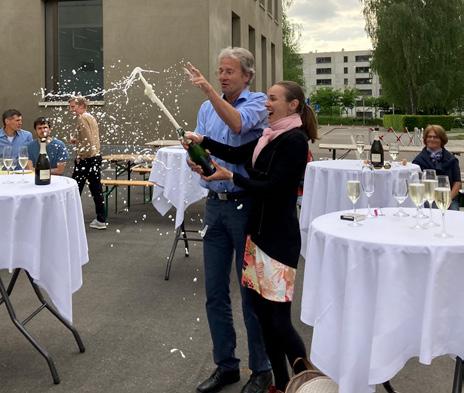
The opening ceremony of the new imaging building took place in May 2022, with Director of Equine Surgery Prof. Dr. Anton Fürst and guest of honor Martina Hingis. The new facilities and equipment for various imaging procedures for horses and farm animals, are a landmark development for the University Animal Hospital. The Vetsuisse Faculty welcomes the high-quality infrastructure for teaching, research and clinical operations.
Skills Lab at Vetsuisse Zurich
With the establishment of the Skills Lab in the 2022 fall semester, students of the Vetsuisse Faculty Zurich can pursue independent learning of valuable clinical skills. The goal of the lab is to reduce animal stress according to the 3R principles in animal research and make teaching at the clinic as efficient as possible – real added value for the program!
46 Vetsuisse Faculty UZH Annual Report 2022 Investments
New MRI and CT commissioned in the Clinic for Diagnostic Imaging at the Small Animal Hospital

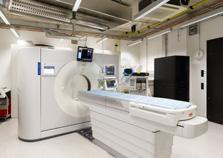


Two new devices – an MRI and a CT – were put into operation at the end of November 2022. The new tomographs are faster, significantly reducing anesthesia time. They also both offer better resolution and numerous new technologies that allow us to provide even better diagnostics. The two new devices put us on the cutting edge of modern diagnostics and provide referring
physicians – such as specialists in neurology, internal medicine, radiation oncology, and orthopedics – with the latest advancements. We will also continue our research at the forefront of our field to deliver internationally competitive results – for ultramodern, optimal patient care.
47 Vetsuisse Faculty UZH Annual Report 2022 Investments
2 3 3 4 1
1: The new Philips MRI gantry; in white with light and breath camera / 2: Exposed magnet, with next to it the new gradient coil to be instaled in the magnet / 3: The new Philips MRI gantry with examination table; new in white and blue / 4: The new Philips IQon Spectral CT
Image concept of the Vetsuisse Faculty Annual Report 2022
The editorial image series in this year’s annual report offers an insight into the spaces of knowledge exchange at the Vetsuisse Faculty. With the means of mind maps representing individual research projects of the interviewed scientists, the importance of networks and cross-institutional collaboration is displayed.
Vetsuisse Faculty UZH Annual Report 2022
Vetsuisse Faculty UZH
Winterthurerstrasse 260
CH-8057 Zürich
Phone: +41 (0) 635 81 21
vet.uzh.ch
Concept, Design & Layout
Roger Stephan, dean
Jeanne Peter, head of Vetcom, scientific illustrations
Serafina Fratto, graphic design
Editorial board
Writing: Primafila Correspondents team
Project management (texts): Kim Rupli, Primafila AG
Editing and translations: Morven McLean & Blas Ulibarri, Primafila AG
Photos
Michelle Aimée Oesch, science photographer
48 Vetsuisse Faculty UZH Annual Report 2022

vet.uzh.ch





 "FEATHER Trial" by Carla Rohrer Bley; Workroom, Small Animal Clinic
"FEATHER Trial" by Carla Rohrer Bley; Workroom, Small Animal Clinic



















 Carla Rohrer Bley in the radiation therapy facility, where she treats cats and dogs with cancer. Her goal: to improve current treatments.
Carla Rohrer Bley in the radiation therapy facility, where she treats cats and dogs with cancer. Her goal: to improve current treatments.
 Raffaella Santoro has found a creative and playful way to explain her fundamental research: The bowl of woollen balls represents the cell nucleus with its chromosomes.
Raffaella Santoro has found a creative and playful way to explain her fundamental research: The bowl of woollen balls represents the cell nucleus with its chromosomes.


 "Soft Tissue Sarcoma" by Enni Markkanen; Media room, Small Animal Clinic
"Soft Tissue Sarcoma" by Enni Markkanen; Media room, Small Animal Clinic







 “Tetracycline
Chlamydia suis" by Hanna Marti; Seminar room, Vetsuisse Faculty
“Tetracycline
Chlamydia suis" by Hanna Marti; Seminar room, Vetsuisse Faculty






